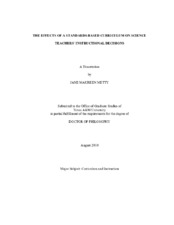| dc.contributor.advisor | Burlbaw, Lynn M. | |
| dc.creator | Metty, Jane Maureen | |
| dc.date.accessioned | 2011-10-21T22:03:19Z | |
| dc.date.accessioned | 2011-10-22T07:10:25Z | |
| dc.date.available | 2011-10-21T22:03:19Z | |
| dc.date.available | 2011-10-22T07:10:25Z | |
| dc.date.created | 2010-08 | |
| dc.date.issued | 2011-10-21 | |
| dc.date.submitted | August 2010 | |
| dc.identifier.uri | https://hdl.handle.net/1969.1/ETD-TAMU-2010-08-8442 | |
| dc.description.abstract | Teachers are an essential link between the curriculum and student achievement. Teachers make instructional decisions that (1) determine the success or failure of a curricular intervention and (2) can result in either alignment or disconnect between the written and enacted curricula. Despite overwhelming evidence linking the success or the failure of a curricular intervention to the classroom teacher, little is known about the instructional decisions teachers make when using a standards-based curriculum. The use of standards-based curriculum is becoming common, therefore, it is essential to know how teachers are using it.
This study focused on three questions. First, can the factors that influence instructional decisions be consolidated into manageable, representative, and useful categories? Second, what instructional decisions did six science teachers in a rural central Texas school district make when using the standards-based curriculum, CSCOPE? Finally, what steps did one district take to select and adopt the SBC, CSCOPE?
This study found that the factors that influence instructional decisions could be clustered into four categories: (1) working conditions, (2) pedagogical content knowledge, (3) prior experiences, and (4) beliefs. Further, that teachers made instructional decisions both to use CSCOPE as intended and to modify CSCOPE lessons. Modifications to CSCOPE were made despite (1) an administrative mandate not to modify CSCOPE, (2) good administrative support, and (3) the stated intention of these teachers to adhere to CSCOPE. Teachers omitted, replaced and/or supplemented lessons and/or parts of lessons in order to (1) accommodate the needs of their students and (2) prepare students for the state assessment. Finally, several steps taken by Bluecat ISD administrators assisted teachers in using CSCOPE as intended.
This study makes three contributions to the educational literature. First, no useful categorization exists of the factors that influence teachers‟ instructional decisions. Chapter II provides an initial categorization of these factors that is manageable, representative, and useful. Second, administrators need to be able to anticipate how teachers may use a standards-based curriculum. Chapter III identifies the instructional decisions made by these six science teachers. Chapter IV identifies the measures put in place to support teachers as they adjusted to CSCOPE. | en |
| dc.format.mimetype | application/pdf | |
| dc.language.iso | en_US | |
| dc.subject | Science Education | en |
| dc.subject | education | en |
| dc.subject | curriculum | en |
| dc.subject | standards-based curriculum | en |
| dc.subject | teacher practice | en |
| dc.subject | teacher instructional practice | en |
| dc.subject | science teacher decision-making | en |
| dc.subject | CSCOPE | en |
| dc.subject | science teacher instructional practices | en |
| dc.subject | teacher use of standards-based curriculum | en |
| dc.subject | science curriculum | en |
| dc.subject | administrative practice | en |
| dc.subject | district adopted curriculum | en |
| dc.title | The Effects of a Standards-Based Curriculum on Science Teachers' Instructional Decisions | en |
| dc.type | Thesis | en |
| thesis.degree.department | Teaching, Learning, and Culture | en |
| thesis.degree.discipline | Curriculum and Instruction | en |
| thesis.degree.grantor | Texas A&M University | en |
| thesis.degree.name | Doctor of Philosophy | en |
| thesis.degree.level | Doctoral | en |
| dc.contributor.committeeMember | Schielack, Jane F. | |
| dc.contributor.committeeMember | Kelly, Larry J. | |
| dc.contributor.committeeMember | Smith, Dennie L. | |
| dc.type.genre | thesis | en |
| dc.type.material | text | en |


